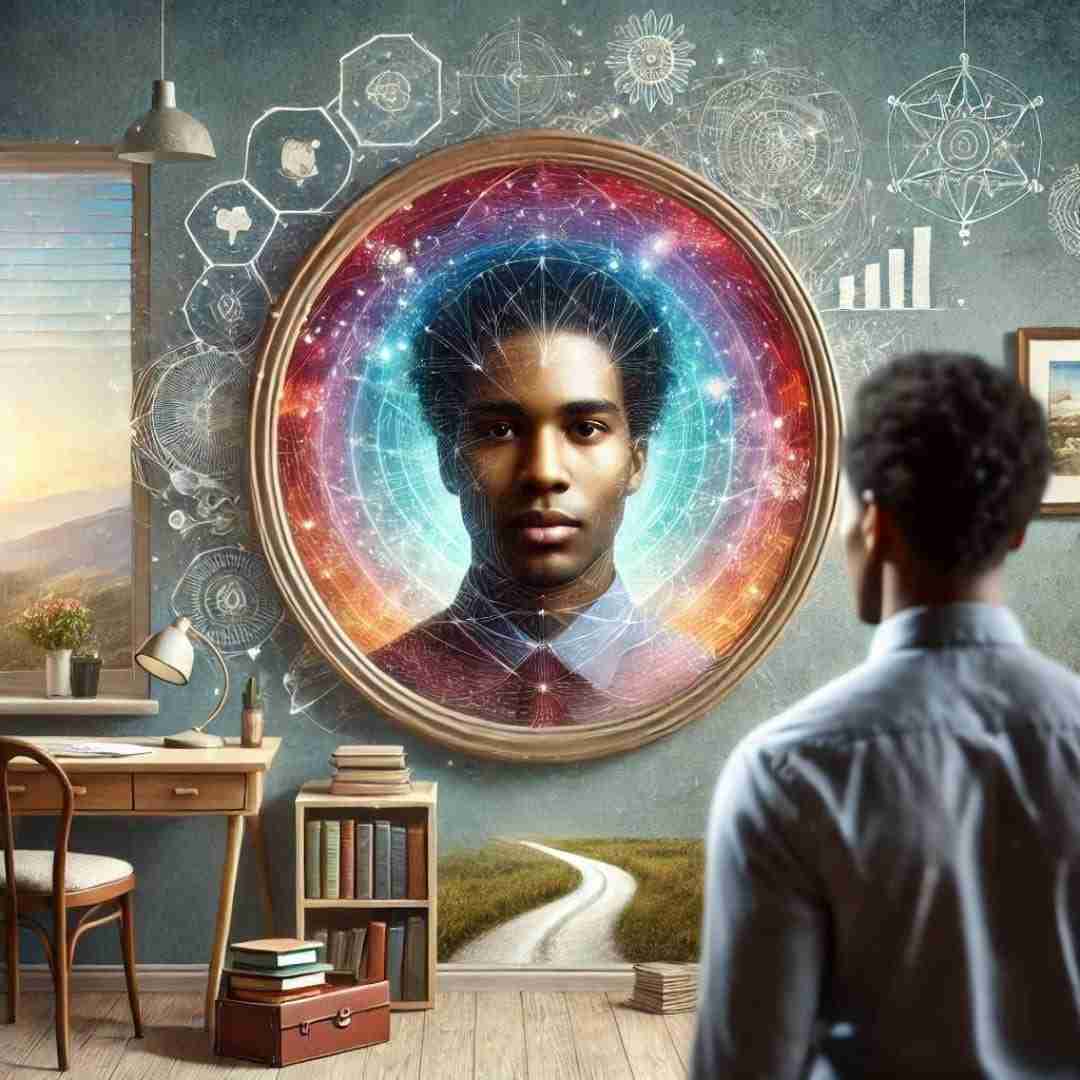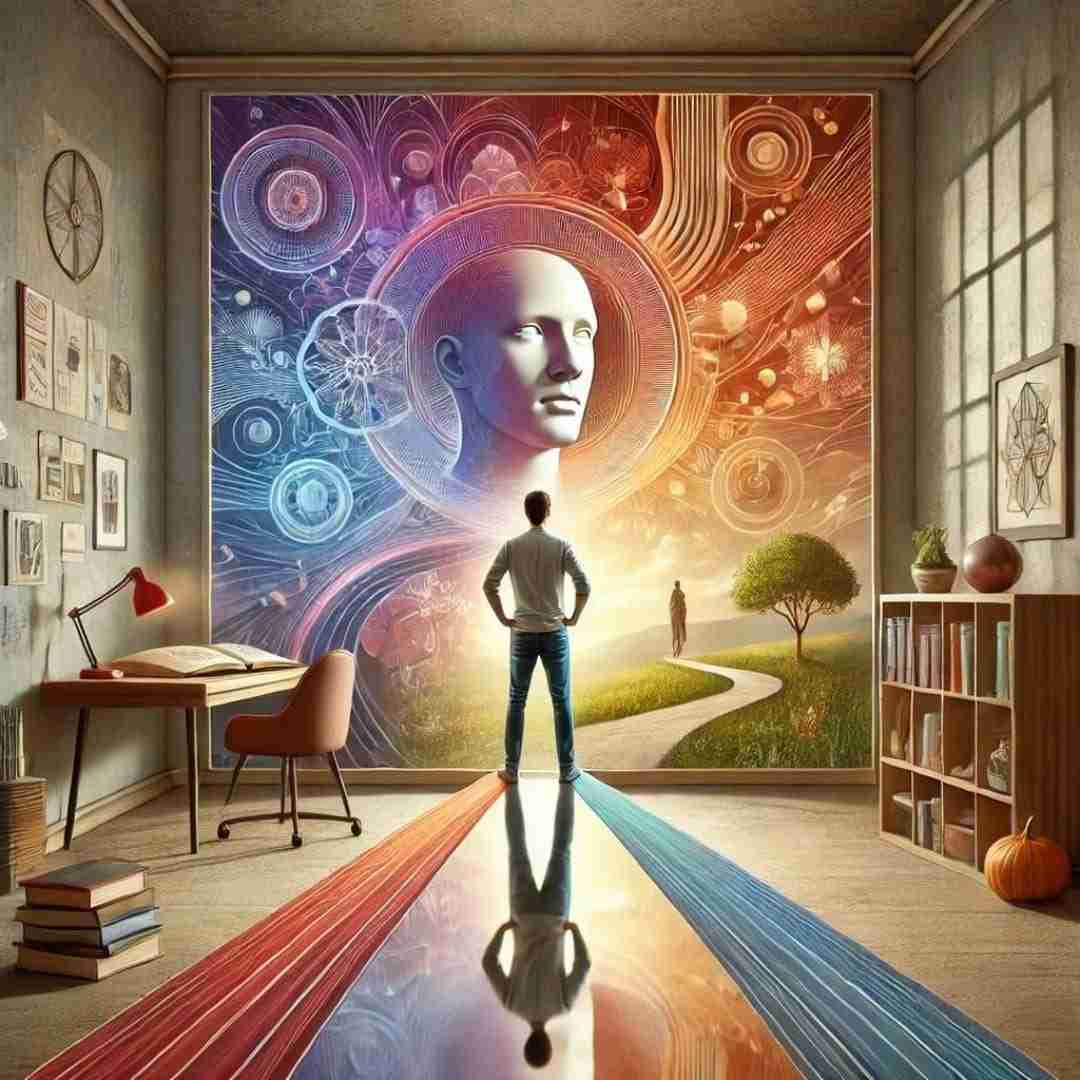Have you ever wondered why you view yourself so differently than others view you? It’s called self-perception. It’s an essential part of who we are, yet many of us are unaware of it or rarely stop to consider it. Self-perception is all about how we see ourselves on the deepest level: from our beliefs and feelings to our thoughts about our abilities. It also includes our ideas about our appearance and personality.
Let’s take a little journey through the world of self-perception to better understand what it means, why it’s important, and how we can positively shape our own self-perceptions. After reading this article, you will have a better understanding of yourself and how your self-perception (SP) affects your professional life, relationships, and ability for personal growth.
My Take on Self-Perception

To me, understanding your self-perception is like looking into a mirror that reflects not just your physical appearance but your entire being. This being is made up of four key components:
Self-Concept
This is the big picture of who I am. It’s the understanding of my traits, behaviors, and attributes that I’ve gathered over the years.
Self-Esteem
This is about how much I value myself. When I have high self-esteem, I feel confident and worthy. When it’s low, I struggle with feelings of inadequacy.
Self-Image
This is the mental snapshot I have of myself, which includes my physical appearance, personality traits, and social roles.
Self-Efficacy
This is my belief in my ability to succeed in different situations. It’s like my personal cheerleader that boosts my motivation and perseverance.
Understanding and being aware of these four components is crucial to our well-being. They shape how we view ourselves and interact with the world. By recognizing and nurturing these aspects while observing our own behavior, we can build a more accurate self-perception.
Factors That Shape My Self-Perception

A lot of things influence how I see myself, including:
Personal Experiences: My successes and failures, the feedback I get from others, and my personal achievements all play a big role in shaping my self-perception.
Social Interactions: My relationships with family, friends, and peers, along with societal norms and expectations, significantly impact how I view myself. Assumptions of poor social skills due to a lack of dating experiences can also influence self-perception.
Cultural Background: My cultural beliefs and values shape my self-perception, especially regarding individual versus collective achievements.
Media and Society: The media’s portrayal of beauty, success, and behavior standards can affect my self-image and self-esteem.
These factors intertwine to form the lens through which I view myself. By understanding the influence of personal experiences, social interactions, cultural background, and media, I can gain a clearer, more balanced SP and better navigate my journey of self-discovery.
Perception Theory & Cognitive Dissonance Theory Can Help Us Understand Ourselves
There are some cool theories out there that help explain self-perception. Here are the two big ones:
Self-Perception Theory
This theory comes from the work of psychologist Daryl Bem, a prominent figure in social psychology. Bem made significant contributions to the field with his research on attitudes and behavior.
Bem’s Self-Perception Theory, proposed in 1972, challenges traditional notions of how we form our attitudes and opinions. Instead of assuming that our attitudes directly influence our behaviors, Bem suggested that we often deduce our attitudes by observing our behaviors, especially when internal cues are weak or ambiguous. This is akin to an external observer making judgments about our attitudes and attitude statements based on our actions.
One of Bem’s notable studies illustrating this theory was published in the Journal of Personality and Social Psychology in 1972. Participants were asked to engage in behaviors that contradicted their initial attitudes. For instance, individuals who were initially indifferent or slightly opposed to a topic were asked to write essays in favor of that topic. After engaging in this behavior, participants were found to change their attitudes to be more in line with their actions. This phenomenon, known as the “foot-in-the-door” technique, supports the idea that behavior can lead to attitude change.
Self-Perception Theory has significant implications for understanding how we develop self-knowledge and how that knowledge affects our behavior. For example, if I find myself often helping others, I might conclude that I’m a kind and compassionate person. This inference process helps me construct my self-concept and can influence my future behaviors and decisions.
Cognitive Dissonance Theory
Cognitive Dissonance Theory was developed by Leon Festinger, a pioneering social psychologist whose work has had a profound impact on the field. It is also referred to as the Cognitive Dissonance Phenomena.
Festinger introduced Cognitive Dissonance Theory in 1957 with his seminal book A Theory of Cognitive Dissonance. This theory suggests that individuals have an inherent drive to maintain internal consistency among their beliefs, attitudes, and behaviors. When there is a conflict between these elements, it creates a psychological discomfort known as dissonance. To alleviate this discomfort, individuals are motivated to change either their beliefs or their behaviors to achieve consistency.
In one of Festinger’s most famous studies demonstrating cognitive dissonance, known as the “induced compliance paradigm,” participants were asked to perform a tedious task and then persuade others to do the same by lying that the task was enjoyable. Participants were paid either $1 or $20 for this deception. Interestingly, those paid $1 experienced more cognitive dissonance because the small reward was insufficient justification for lying, leading them to change their attitudes and actually believe the task was enjoyable. In contrast, those paid $20 had sufficient external justification and experienced less dissonance.
Cognitive Dissonance Theory explains why people often go to great lengths to justify decisions, even when evidence suggests those decisions were flawed. For example, if someone who values health continues to smoke, they might experience dissonance and resolve it by downplaying the risks of smoking or convincing themselves they can’t quit.
The concept of cognitive dissonance remains a cornerstone in social psychology,
providing a framework for understanding how and why we strive for internal consistency and how we manage the discomfort of conflicting cognitions. It highlights the complex interplay between our beliefs and behaviors and the lengths to which we go to maintain a coherent self-concept. Cognitive dissonance serves as an underlying mechanism for behavior change, driving individuals to align their actions with their beliefs to reduce psychological discomfort.
Why A Healthy Self-Perception is Important

Our self-perception has a massive impact on our quality of life. This is particularly true in the arena of mental health, where reflecting on our own behaviors can significantly shape how we view ourselves. Positive SP is linked to higher self-esteem, better mental health, and overall well-being. When SP is negative, it can lead to issues like depression and anxiety.
This ties into our ability to believe in ourselves and succeed when we strive to meet a goal or accomplish something. Essentially, our self-perception can either help or hinder our performance and motivation. Believing in my abilities (self-efficacy) positively influences my motivation and performance. When I believe in myself, I put in more effort and persist longer in achieving my goals. Self-doubt, on the other hand, can hinder my performance or cause me to give up prematurely.
Healthy self-perception also affects our relationships with others. A positive SP helps us understand and remember that all humans have strengths and weaknesses, which makes us more empathetic and understanding towards others. Empathy and understanding both foster deeper connections and better communication, leading to healthier, more satisfying relationships.
Conversely, a negative SP can result in relationships wrought with conflicts and difficulties. When individuals harbor negative views about themselves, it can manifest in various detrimental ways within their relationships, like communication struggles, jealousy, dependence or withdrawal, emotional reactivity, and trust issues.
Yes, There Is a Difference Between Self-Image & Self-Perception

While closely related and often overlapping, there are key differences between our self-image and our self-perception. This is why it’s possible to have a positive self-image but a negative self-perception or vice versa.
Self-image refers to the mental picture or concept that you have of yourself. It includes:
Physical Appearance: How you see your own body, face, and overall physical attributes.
Personality Traits: The characteristics you believe you possess, such as being kind, intelligent, or funny.
Social Roles: The roles you identify with, such as being a student, parent, or professional.
Personal Values and Beliefs: What you believe in and what you value in life.
Self-image is essentially a snapshot of how you see yourself in various aspects of life. It can be influenced by past experiences, feedback from others, and societal standards.
Self-perception is a broader term that encompasses your overall view of yourself, including how you interpret and evaluate your thoughts, feelings, and behaviors. It includes self-image but also the other three key factors described earlier, self-concept, self-esteem, and self-efficacy.
Self-perception is more dynamic and involves the ongoing process of interpreting and understanding your own actions, thoughts, and emotions. It’s shaped by both internal factors (such as self-reflection and cognitive processes) and external factors (such as social interactions and feedback).
Key Differences Between Self-Image and Self-Perception
Self-image focuses mainly on specific attributes (physical appearance, personality traits, social roles, etc.) and the static mental picture you have of yourself.
SP, on the other hand, encompasses a broader and more dynamic understanding of yourself. It involves continuous self-assessment and interpretation.
Here’s an example to illustrate the difference. Imagine you are preparing for a big presentation:
Self-Image: You might see yourself as a confident and articulate person who looks professional in your attire. This is how you picture yourself in the role of a presenter.
Self-Perception: You might evaluate your ability to deliver the presentation effectively (self-efficacy), consider your feelings of nervousness (self-esteem), and reflect on your overall identity as a competent professional (self-concept).
While self-image is a crucial part of SP, it’s just one piece of the puzzle. Self-perception includes a wider range of self-evaluations and interpretations, making it a more comprehensive understanding of who you are. Recognizing the distinction between these concepts can help you gain a deeper insight into how you view and understand yourself, ultimately fostering greater self-awareness and personal growth.
If you’re interested in knowing more about the differences between self-perception and self-image, there are significant publications in the field of psychology that highlight the topic, such as The Journal of Experimental Social Psychology and Psychological Review.
Why Is My Self-Perception So Different From How Others See Me?

Our self-perception often differs from the way others perceive us, and this is a fascinating phenomenon. The underlying mechanism behind this difference involves complex psychological processes, including self-perception theory.
Cognitive dissonance phenomena plays a crucial role in this process, too, as it highlights the psychological tension that arises when our self-perception conflicts with external feedback. Here are a few more factors that affect why we see ourselves differently than others see us:
Internal vs. External Perspectives
Every human being has a “self-focused lens.” Our self-perception is primarily based on an internal perspective. We have access to our thoughts, feelings, and intentions, which others cannot see. This internal lens means we are acutely aware of our insecurities, doubts, and perceived flaws, which can skew our self-view.
Meanwhile, others see us from an external perspective. They observe our behaviors, actions, and expressions but do not have direct access to our internal world. This external viewpoint can lead to a more objective assessment of our capabilities and personality traits. Observing our own behavior can also shape our self-perception, as we infer our attitudes and self-image from our actions.
Selective Attention and Memory
As humans, we have what is called an attention bias. We tend to focus more on our mistakes and shortcomings, which can dominate our self-perception. In contrast, others might not notice these as much and may focus more on our positive qualities and successes.
We also have a memory bias. We remember our past failures and embarrassing moments more vividly, which can negatively influence our self-perception. Reflecting on our own behaviors, as highlighted by self-perception theory, can further shape how we interpret our thoughts and feelings based on our actions. Others might have forgotten these events or never noticed them in the first place.
Impression Management
We’re aware of our self-presentation, meaning we manage the impression we give to others. We often show our best sides in social situations, which means others might see a polished version of ourselves rather than the full, unfiltered picture we see.
We wear different “masks” in different contexts (e.g., professional, social, family). These masks can lead others to see only specific aspects of our personality, which might differ from how we perceive ourselves when we are alone, influencing our beliefs and attitude statements.
Bridging the Gap
Understanding these differences can help us be kinder to ourselves and appreciate that our view is just one perspective among many. By doing so, we can develop a more balanced and accurate view of ourselves, aligning our self-perception more closely with the often more positive perspectives of those around us.
Practical Tips for Improving Self-Perception
For me (as I assume it is with most people), improving my self-perception is an ongoing journey. It involves a constant, conscious effort to have self-love and compassion, remembering that my view of myself is often negatively skewed.
Here are the most effective ways I’ve found to improve self-perception when done on a regular basis:
Self-Awareness
Engaging in self-reflection helps me understand my thoughts, feelings, and behaviors better. Journaling and mindfulness practices like meditation and yoga have been particularly useful in building awareness.
Positive Self-Talk
Challenging negative thoughts and replacing them with positive affirmations and realistic self-appraisals boosts my self-esteem.
Seeking Feedback
Getting feedback from trusted friends, family, or mentors to gain a more balanced view of my strengths and areas for improvement.
Practice Self-Compassion
Reminding myself that everyone has strengths and weaknesses, and I should treat myself with the same kindness and understanding that you would offer a friend.
Self-perception (SP) is a dynamic and multifaceted concept that significantly influences our daily lives. By understanding and improving our SP, we can enhance our overall well-being and live more fulfilling lives.
Finding Your Positive SP

Self-perception is a fundamental aspect of our identity that shapes how we see ourselves and how we interact with the world. By fostering a positive self-perception, we can enhance our mental health, build stronger relationships, achieve our goals, and lead a more satisfied life.
So, the next time you catch yourself reflecting on who you are, remember that how you see yourself can shape your entire world. Embrace the journey of self-discovery and let your self-perception be a positive force in your life!




























0 Comments